
Cuffs on Boys' Shirts and Blouses
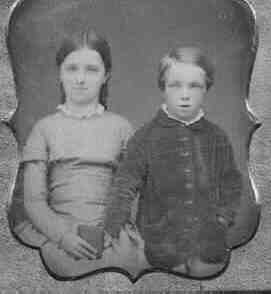
Figure 1.--Boys' collars in the mid-19th Century took many shape, including ruffles. They were, however, generally quite small and usually not very elaborate. They stand out from the much larger collars worn earlier and later in the decade. They did not, however, commonly have elaborate cuffs.
|
Boys over the ages have worn a variety of shirt cuffs. All shirts had cuffs through the early 20th century because they all long sleeves. Cuffs varied greatly over time, ranging from elaborate lace and ruffles matching the collar to very plain cuffs without embelishment. Some of the most elaborate boys cuffs appeared during the Fautleroy craze of the late 19th century. Since then boys have generally worn very plain shirt cuffs with single button closure.
In some eras they were identical or similar to men's collars, such as in the 18th Century jabots or in the modern era. In other times cuffs could be quite different, such as sailor cuffs and Fauntleroy lace and ruffle cuffs.
Chrnological Development
The cuffs on boys' shirts have varied substantially over time. At times quite different than their fathers at other times identical.
The 17th and early 18th century
Boys until the late 18th century, after breeching, wore the same shirts as their fathers. This included the elaborate lace and ruffled cuff trim of the Cavilier era in the 17th century. This did not disappear in the 18th century. Boys at the beginning of the 18th Century wore the same lacey jabots and fancy cuffs there fathers continued to wear. Many elaborate dress shirts included fancy cuffs, with boys' shirt basically scaled down versions of their father' shirts. Of course shirts for every day wear by the general populatiin had plain cuffs.
The late 18th century
Specially designed shirts for boys appeared in the late 18th century. At the time they were worn with skeleton suits. Ruffled collars, usually open collars, were commonly worn with these early skeleton suits. One of these fashions was an open ruffled collar. Adults wore ruffled collars, but not open ruffled
collars like boys. Some, but not all, of the shirts and blouses for boys' skeleton suits also had matching ruffled cuffs.
Early 19th century
Skeleton suits in the early 19th century continued to be worn with ruffled collars after the turn of the century. Gradually the collars became less fancy and were worn closed. At the same time it became increasingly less common to wear matching ruffled cuffs. Boys began wearing shirts and blouses with simple cuffs, even for dress occassions.
Tunics were another popular style for boys during the early 19th century. I do not have, however, details on what kind of shirts boys wore under their tunics, including the cuff style.
Mid-19th century
Skeleton suits disappeared in the 1840s and boys began to wear more recogniably modern jackets ans shirts. Some shirts had collars and cuffs with modest ruffles, but most shirts were plain. Some boys wore shirts with wide white collars, but these shirts generally had very plain cuffs. The most distinuishing feature of boy's collars and cuffs at mid-century was that they were generally small. They were not nearly as an important fashion element as they were to become later in the century.
Late 19th century
Collars began to increase in size in the late
19th Century, but cuffs did not immediately follow suit. Boys collars began to become a more important element of a boys' outfit in the 1870s and by the 1880s they could be quite large and elaborate. The cuffs generally followed suit. New fashions appeared like lace collars for boys. After the Fauntleroy craze of the mid-1880s, the size of the collars increased significantly. Some became very large indeed. The most elaborate cuffs were those associated with the Fauntleroy look. Other styles, however had more modest cuffs.
Older boys wore stiff Eton collars. All collars were worn buttoned tightly closed.
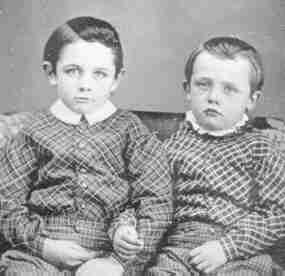
Figure 2.--Many classic boys collars were worn in the mid-19th Century, but they were generally much smaller than those worn later in the century. These boys wear an Eton and a ruffled collar. Note that neither has visible cuffs.
|
Early 20th Century
Lace collars and cuffs became less prevalent after the turn of the century, but ruffled collars and matching cuffs became more common. Wide white collars were worn with Buster Brown suits and they sometimes had matching white cuffs. The Peter Pan collar became popular for young boys while older ones continued wearing Eton collars until the 1920s when they were increasingly repalaced by soft collars. These shirts and blouses did not have destnctive cuffs.
Mid-20th Century
The major development during the mid-20 century was the increasing popularity of short sleeves and the declining importance of cuffs. Shirts generally had not destinguishing cuffs. The only exception was blouses for a small boys' dress wear. Even the short sleeved versions might have decorative trim.
Late 20th Century
No major developments concerning cuffs occurred in the late 20th Century. The only development of note was that French cuffs have virtually disappeared for boys' wear.
Cuff Styles
Boys' fashions have included a wide variety of shirt cuffs. The collar was one the most important feature of boyhood clothes. It is now much less common.
Basic wrist cuff
Many boys shirts and blouses have had very simple cuffs. Some shirts had no cuff at all. Others simply had an added layer of material with a button or opening for a cufflink closing. It is difficult to see this reinforced wrist cuffs on solid colored shirts. They are somewhat more visible on patterened shirts as the pattern is often not alligned.
Destinctive styled wrist cuff
Important shirt cuff styles have included:
Ruffled cuffs: Ruffled cuffs matching the collar were widely used for boys in Regency fashions during the late 18th and
early 19th centuries. The most common style using ruffled cuffs were:
skeleton suits,
tunics, but rarely smocks.
The dominate point of the shirt or blouse was the collar. Sometimes the style of the ruffled collar was replivated in the cuffs, but sometimes plains cuffs were used.

Figure 3.--Middy blouses with sailor collars were one of the most enduring of all boys' fashions. Usually the middy blouse had stripes at the cuffs matching the stripes on the sailor collar.
|
Sailor collars: Middly blouses and sailor suits for boys first appeared in England during the 18th century. They became very popular for boys in England after Nelson's great victories over the French and especially when Queen Victoria began dressing her children in them during the
mid-19th Century.
The fashion soon spread to America and Europe. The collar was cut in a "v" in front and a wide rectangle in back. Many relocated the stripes on the collar at te cuffs. Proper middy blouses came in blue for winter wear or white for summer wear and had three white stripes for Nelson's three great victories. It was often worn with a bow in front. The middy blouse and sailor suit was one of the most popular
styles of all time for boys. Sailor suits came in many different styles and were worn with skirts/kilts and knee, short, and long pants. Sailor suits went out of style for older boys in England abd America
after the First World War, but was commonly worn bu smaller boys. The style remained popular on the Continent during the 1920s and 1930s, even for older boys. While little worn by boys of any age today, they are used by sone choir groups or at formal weddings. They are still worn by girls and are standard school uniform wear for Japanese and Korean school girls.
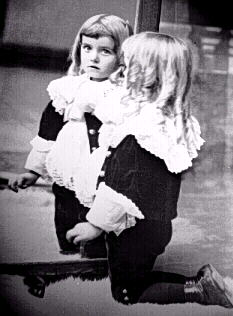
Figure 4.--Note the elaborate lace collar and matching wrist cuffs that come almost to the elbows. This little boy in the 1890s also sported beautifully
done sausage curls. How his mother must have suffered when they were cut.
|
Lace cuffs: Both men and boys wore lace collars and wrist trim during
the Stuart Cavilier period . The style was strongly influenced all over Europe by the court of the famed Sun King (Louis XIV) who dominated Europe throughout the 17th cebtury. Lace in this era was part of a well-dresses gentleman's wardrobe and was just as popular if not more popular for mens' clothes than women's clothes. A later reincanation ocurred in the
1880s, especially in America, with the publication of Little Lord Fauntleroy. Fauntleroy suits, the fashion of velvet knee pants suits, worn with long curls, and lace collars plagued American boys for several decades. A great variety of laces and styles were used with the fancy blouses worn as an integral part of the Fauntleroy look. Blouses were made with fancey collars and cuffs, but sometimes lace trim was sinmply sewed on the jacket collar and cuff. Many boys during the 1880s and 1890s wore lace collars and wrist trim with their best party suit. In some cases it was worn with kilt or even dress outfits for the younger boys. It was probably
the most hated boyhood fashion (at least by the boys) of all time. The lace collar itself was often one of the features of the Fauntleroy suit most disliked by the boys. There is an interesting little scene in Walt Disney's much over-looked film, Song of the South, dealing with the boy's distaste for the lace collar his mother insists that he wear. While the velvet Dauntleroy suit and lace collar may have been more popular in America thab Europe, lace trimmed boys' clothes were probably more common in France and Italy then elsewhere in Europe. Lace trimmed clothes were not nearly as popular in Germany.
Pilgram collars: Large white collars worn by the Pilgrams during the Colonial period appear to have been worn by both men and boys. These large collars declined in popularity in the 18th cerntury. Large white collars were not commonly worn again until after the American Civil War (1861-65). I am not positive yet about the wrist cuff trim.
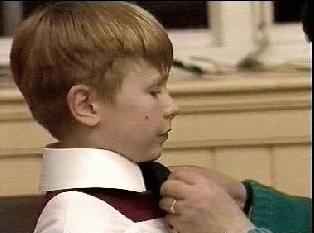
Figure 5.--The Eton collar was once though of as esential for a well dresses boy and was required at many schools. It largely disappeared during
the 1930s, but is still worn by some English boy choirs. There was no destinctive cuff worn with the Eton collar.
|
Eton collars: Eton collars were large stiff white collars worn
by the students at Eton school. Given the prestige of Eton, the fashion of Eton collars became
widely worn both in England and America during the late 19th and early 20th Centuries. Eton suits were worn by the junior boys at the school. They had short jackets were worn with the stiff Eton collars. They certainly looked uncomfortable, but many at the time did not believe a boy to be well dressed without a Eton collar. Eton collars proved so popular that they were used with many garments besides school
uniforms. Little boys wore them with dresses and kilts. Older boys wore them eith suits--especially Norfolk suits. Boys wore a varitiy of ties and bows with
their Eton collars. Younger boys may have worn large floppy bows. Older boy might have worn a type of bow tie or a necktie with a large knot and small vertical fall. Some Eton collars were worn with no bow
or tie. I am not sure about the cuffs worn with Eton collars
Smocked collar: Some boys were
dressed in smocked collars for
formal occasions such as weddings, often serving as
ring bearers at weddings. Smocked collars are large, usually white collars with elaborate embroidery work. The pictures I have seen have been from
weddings beginning about the 1950s. I am not sure about the wrist trim worn with smocked collars, but believe there was generally no destinctive trim.
Soft collars: The standard soft collars generally worn by boys today
became accepted in the 1920s, replacing the Eton collars commonly worn at the beginning of the century. Over time there have been many inovations worn by
both men and boys, such as tabs, pins, and the most enduring, button downs. Fashion trends generally focused on the collar with little generally little change to the cuff.
French cuffs: Expensive men's white shirts in the early and mid 20th century often had French cuffs. I do not know about the origin of this style and to what extent it was actually associate with France. The French cuff doubled over and was closed with cuff links rather than buttons. French cuffs were less common for boys, although they were widely worn for dress wear until the 1960s.
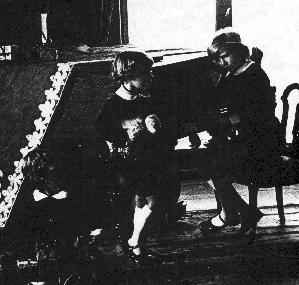
Figure 6.--Formal velvet Eton suits were often worn with blouses that had Peter Pan collars. The blouses often had short sleeves or long slleves without destinctive cuffs.
|
Peter Pan collars: Peter Pan collars are more associated with
girls. Younger boys dressed in shortalls
or Eton suits for formal occasions commonly
wore Peter Pan collars beginning I think in the 1940s. Formal velvet Eton suits were especially likely to be worn with Peter Pan collars. The fashion passed
out of style for all but the youngest boys after the 1970s. I'm not sure as to how this style developed, but would be interested in any insights visitors to this web site might have. Peter pan blouses often had short sleeves or long slleves without destinctive cuffs.
Christopher Wagner
histclo@lycosmail.com
Navigate the Historic Boys' Clothing Web Site:
[Introduction]
[Chronologies]
[Style Index]
[Activities]
[Artists]
[Photography]
[Countries]
[Contributions]
[Boys' Clothing Home]
Navigate the Historic Boys' Clothing Web chronological pages:
[The 16th Century]
[Early 1800s]
[The 1880s]
[The 1900s]
[The 1920s]
[The 1950s]
Navigate the Historic Boys' Clothing Web style pages:
[Dresses]
[Smocks]
[Bows]
[Bodice kilts]
[Kilts]
[Sailor suits]
[Eton suits]
[Blouses]
[Ring bearer/page costumes]
[Fauntleroy suits]
Created: September 4, 1998
Last updated: September 4, 1998







